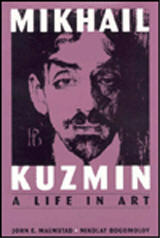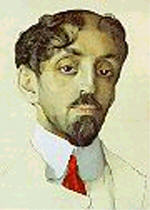 |


|
|
A Life in Art University of Glasgow Mikhail Kuzmin: A Life in Art by John E. Malmstad and Nikolay Bogomolov, Harvard University Press, 1999, 463 pages, cloth, $49.95
 Poet, novelist, diarist, dramatist and musician, Mikhail Alekseevich Kuzmin (1872–1936) wrote, arguably, the first modern coming-out novel with an optimistic ending. His Kryl'ia ("Wings"), published in St Petersburg in 1906, embedded the theme of same-sex love in Russian culture in an unapologetically affirmative key.
Poet, novelist, diarist, dramatist and musician, Mikhail Alekseevich Kuzmin (1872–1936) wrote, arguably, the first modern coming-out novel with an optimistic ending. His Kryl'ia ("Wings"), published in St Petersburg in 1906, embedded the theme of same-sex love in Russian culture in an unapologetically affirmative key.
Kuzmin continued to celebrate male love in his works with a degree of confidence that his analogues in western Europe failed to match. After the blazing debut of Wings, Kuzmin gained respect for the "beautiful clarity" of his poetic voice, rooted in the present and its charms, a bracing shift from the Symbolism of an earlier generation. Kuzmin too was a poet who mined his own biography, incorporating its associations and events in his poem-cycles. Naively apolitical in the most volatile of political environments, he hailed and then rejected the Bolshevik Revolution of October 1917. Too indigent and stubborn to emigrate, he struggled to find enough literary commissions to survive in Soviet times. Despite his status under Bolshevism as a cultural anachronism, much of Kuzmin's artistically most successful work was produced after 1917. As censorship tightened and ideological wars raged in proletarian literature, Kuzmin's diary (1906-1934) chronicled a life lived through sexuality, art and contemplation of the everyday. His finest autobiographical poem cycle, The Trout Breaks through the Ice (published in 1928) demonstrated the muscularity and range of his mature voice, and evoked a reply from Anna Akhmatova, her famous Poem without a Hero.
Malmstad devoted great energy to the recovery of Kuzmin's biography and works, despite being denied a Soviet entry visa during the 1970s, apparently for this unacceptable interest. A 1977 monograph, based on interviews and documentation obtained unofficially from archives through Soviet researchers, presented a "best available" portrait of the life. The present biography, written with Russian Kuzmin authority Nikolay Bogomolov, is nothing short of thrilling, for it represents the fruits of the new openness in post-Soviet scholarship. In particular, Kuzmin's diary, now accessible and gradually seeing annotated publication, has brought the poet's homosexuality to the fore in what has now become (as 69 pages of notes attest) the sub-field of Kuzmin studies. Malmstad and Bogomolov have produced one of the cornerstones upon which Russian gay studies will be built. Their chief argument, convincingly made, is that Kuzmin's art deserves recognition for its seriousness, in addition to the "carefree and lighthearted" reputation he has long enjoyed. The authors demonstrate that this "light" reputation is a distorting result of Soviet information controls. With freedom to publish Kuzmin's complete works, and especially with access to the diaries, the full spectrum of his wisdom and complexity is revealed. Against this new backdrop, the scandalizing Kuzmin of Wings and affairs with hussars and adventures with bathhouse attendants grows into a figure less noisy but more intently queer. As the authors write, "Same-sex love is the defining fact of Kuzmin's life and art" (p. 10). Here was a radically modern and homosexual author who refused the closet of emigration (with its loss of language), and whose diary reveals his maturing commitment to his lover Yuri Yurkun, and their shared life in increasingly harrowing circumstances.
Curiously, the Russian version never uses the word "gei", and often evades explicit statements about homosexuality so as to hold a stuffy Soviet-minded audience. (Cf. p. 139, "gay society" in English, and p. 136 in Russian; p. 229 "fag hag" in English, and p. 181-82 in Russian.) It seems sad that Americans (and those of us tagging along in English-speaking markets), enjoying a flood of queer scholarship, can buy a "gayer" Kuzmin than the Russians, who surely need one as much as we do, if not more. Literary scholars who care about the revolutionary period may take issue with the authors' fashionably post-Soviet dismissal of the era's literary politics (e.g., p. 338). They meant little to Kuzmin, but their progress dictated the opportunities that shaped his existence. It is ironic, given his spendthrift ways, that Kuzmin enjoyed his final years (years of famine and terror in the countryside), receiving guests to tea in his salon, thanks to friends who organized his entry into the Union of Soviet Writers. Historians will consider that the conceptualization of the sexual culture Kuzmin lived in deserves strengthening in this account. Presumably because the core of this book was laid down in the Russian original as early as 1991, the authors have not addressed the important work about modern Russian sexualities by Laura Engelstein of Igor Kon. A variation between Russian and English texts illustrates the problem. In Russian, an eyewitness describes Kuzmin's final public reading (in Leningrad in 1928) as "the last demonstration of Petersburg's pederasts" (p. 260), while in English it is "the last demonstration of Leningrad's homosexuals" (p. 349). I suspect the speaker actually said "Petersburg" and "pederasts", and that the tidying obscures important differences. (For the same operation, see Alexander Poznansky, Tchaikovsky: The Quest for the Inner Man [New York: Schirmer Books, 1991], p. 626 n. 47.) Similarly, the authors refer to people, bathhouses and plots as "gay" in the English text, but not enough is offered to give the term either social or discursive context. History-conscious readers will wonder how a St Petersburg "gay" bathhouse in 1906 differs from the diverse post-HIV "gay" baths of our own heterogenous and not always American experience. To be fair, Malmstad promises a forthcoming article on these questions in Journal of the History of Sexuality. Yet as he and Bogomolov have resolved that their English readers deserve a Kuzmin for whom "same-sex love is the defining fact", they could have provided more purchase on what, in the context, that meant. These quibbles of a pedantic constructionist nature are not meant to undermine the signal importance of this book. We still have far too few works about queer life and history east of the Brandenburg Gate. Queer theory and queer history are hobbled by a parochial focus on the American experience. At last we have an accurate, archive-based, and exhaustively researched account of this forgotten "northern Wilde": a major icon in our heritage has been restored to its proper place. This review is reprinted with permission from The Newsletter of the Committee on Lesbian and Gay History, Vol. 12 No. 3 (Fall 1999) Courtesy of the International Gay and Lesbian Archives |
 © 1997-2000 BEI
© 1997-2000 BEI
 This English-language version of the Malmstad-Bogomolov project differs somewhat from a Russian version issued three years ago (Mikhail Kuzmin: Iskusstvo, zhizn', epokha [Moscow: "Novoe literaturnoe obozrenie", 1996]). Some welcome differences in the English version reflect new biographical revelations in the intervening years. Others are explicable with reference to the conventions of scholarship in Russia and America, such as the frank statement (for English-language readers) about "same-sex love" cited in the preceding paragraph. The same reflections get a euphemistic explication in Russian.
This English-language version of the Malmstad-Bogomolov project differs somewhat from a Russian version issued three years ago (Mikhail Kuzmin: Iskusstvo, zhizn', epokha [Moscow: "Novoe literaturnoe obozrenie", 1996]). Some welcome differences in the English version reflect new biographical revelations in the intervening years. Others are explicable with reference to the conventions of scholarship in Russia and America, such as the frank statement (for English-language readers) about "same-sex love" cited in the preceding paragraph. The same reflections get a euphemistic explication in Russian.